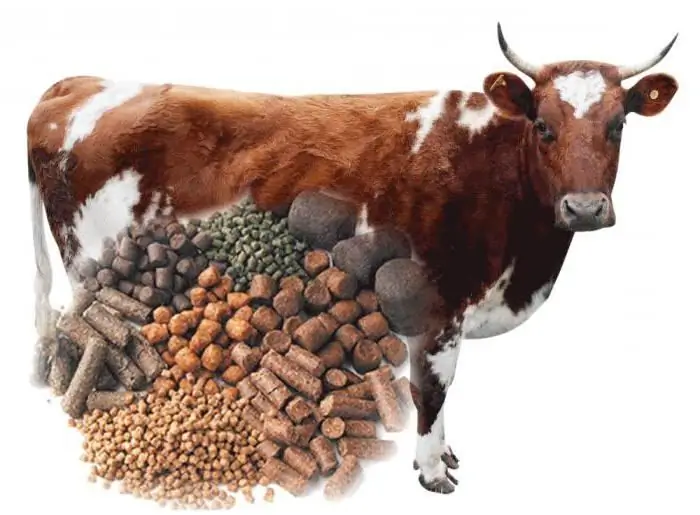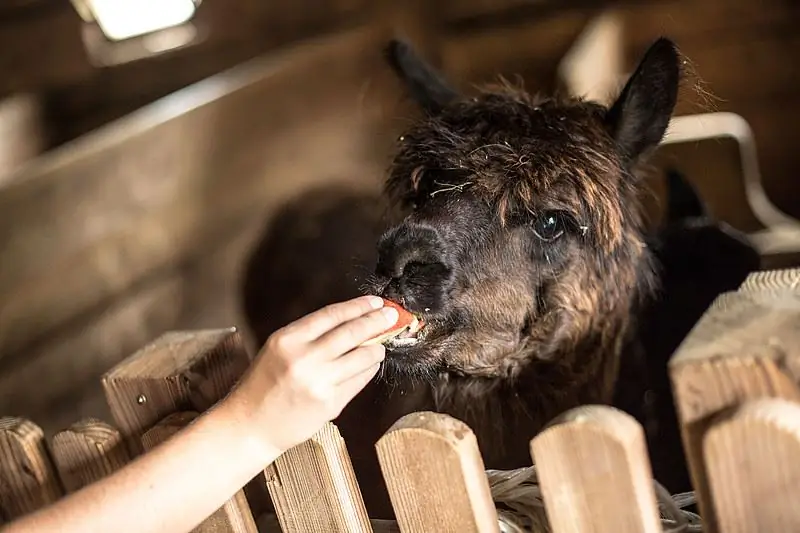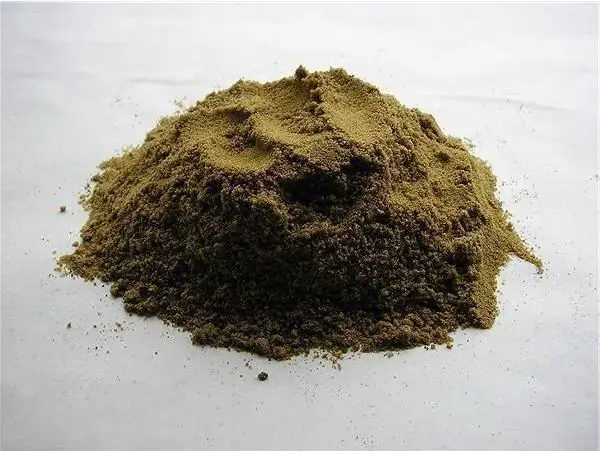2026 Author: Howard Calhoun | [email protected]. Last modified: 2025-01-24 13:10:26
Grass flour is one of the best feeds for farm animals and poultry. In terms of nutritional value, it surpasses hay and silage by several times, the content of proteins and vitamins in it is much higher than in grain mixed feed.
The benefits of grass feed in livestock and poultry
In subsidiary farms and on farms, in the old fashioned way, hay, silage, grain feed, straw and branch fodder, as well as root crops are harvested for the winter. Modern technologies allow grass forage to be harvested with much greater productivity.
In cattle breeding, pig breeding, rabbit breeding and even poultry farming, grass feed plays a huge role. The climate of our country does not allow the use of fresh grass and free pasture all year round. For this, various systems of grass conservation have always been used to feed animals in the cold season.
The simplest thing is, of course, hay making. At all times there was a period of haymaking. Mowed and dried grass in the meadows was collected and stacked. In winter, the cattle were fed with hay. Hay is well stored, but when dried in the sun, up to 50% of its useful substances are lost. Most hayloses carotene, protein and vitamins, the sun's rays destroy them very much.
Preparing feed in the form of silage significantly improves its usefulness, but it is impossible to feed only with silage. Root crops and crushed grain are very good food, but they are inferior to fresh grass in terms of the content of useful substances. In addition, root vegetables also need to be crushed, and they quickly deteriorate, which can cause intestinal disorders in animals.
Nutrition value of herbal flour

Grass meal is close to fresh green grass in terms of nutrient content. Even with long-term storage (8-10 months), it retains up to 95 percent of useful substances. The content of protein, carotene, sugar, vitamins and other substances depends on the herb from which it was made.
The best herbal flour in terms of nutritional value is flour from mowed grasses during the budding period, before flowering. During this period, herbs are the richest in vitamins, carotene and all useful substances. If you are late with mowing, then the content of protein and other nutrients is significantly reduced, only the fiber content increases.
The preservation of carotene in flour depends on the conditions of its storage. If it is stored in bulk, then up to 50 percent of the substance is lost, and if the flour is compressed into granules, then the loss of carotene will be no more than 10 percent over 10 months of storage.
Types of herbal flour
There are several types of herbal flour: from alfalfa, clover, vetch-oat mixture and herbs. According to the content of carotene, protein andother useful substances herbal flour is divided into 3 classes. The smaller the class, the less useful substances in the flour. Therefore, the best flour is 1st grade.
In terms of the content of vitamins, macro- and microelements, carotene and protein, as well as amino acids, herbal flour made from alfalfa is the leader. In addition, after mowing, alfalfa quickly recovers, so it can be mowed three times per season for flour production. This significantly reduces the cost. Because one area of land is used, and the crop is harvested from it 3 times.
Powdered and granulated herbal flour

Grass flour comes to the consumer in two types. It can be purchased in bulk and in the form of granules.
Loose flour loses nutrients faster, it absorbs more moisture from the air and can cake or mold. In addition, in this form, it takes up too much space, because it is very light. Therefore, it is inconvenient and expensive to store and transport it in this form.
Herbal flour in the form of granules is in great demand. Granulated feed loses less nutrients during storage. The granules are dense, hard and shiny. If the technology is not violated, then they can be stored for a long time without crumbling, they take up much less space during storage and transportation. The granules are essentially a concentrate. For animals, granulated flour is given in portions many times smaller than powdered flour. Therefore, if a granular product is used for fattening animals, then it does not need to be bought in large volumes. It is tooprofitable and convenient.
Production of herbal flour and granules from it
Grass for vitamin flour is mowed until it blooms, but only picks up buds. If you miss this moment, then the grass will lose carotene and protein every day. Mowed chopped grass is transported for artificial drying. The crushed grass is loaded into the drying drum along the conveyor. From there, the dry mass enters the crusher. After the crusher, flour is obtained from dry grass, fed into a cyclone, precipitated and stored in an operational bunker for temporary storage. From this bunker, if necessary, grass flour enters the pressing chamber for the manufacture of granules and volume reduction. The pressed mass is squeezed out through the holes of the matrix and cut off with a knife. Granules are obtained 2-3 cm in radius and approximately 5 cm long. During this procedure, the granules are heated, and so that there is no large loss of carotene, they are placed in a cooling chamber. There they lose excess moisture, become hard and durable. Then they are placed in a temporary storage bin, from where they are packed, packed and stored.
To reduce the cost of artificial drying of grass, a different harvesting system is now being used - drying. With this method, the cut grass is left in the swaths for several hours, and then a special technique collects the swaths, grinds the slightly wilted grass. It is loaded and delivered for further artificial drying. Evaporation of moisture from such raw materials is reduced by almost 2 times, which speeds up and reduces the cost of the whole process. With this method, in the sun, a small amount of water is lost in the windrows.the amount of carotene, so it is not recommended to dry the grass for more than 4 hours.

Store granules and flour in a cool, dry, dark place. The storage must comply with certain microclimate parameters (temperature and humidity).
In order to preserve as much carotene as possible in flour during storage, 0.5 percent sodium pyrosulfite is added to it. For the greatest preservation of nutrients in flour during long-term storage, irradiation with gamma rays is used. The preservation of nutrients is affected by low temperature, darkness and the addition of oxidants to the flour (during granulation).
Quality granules and flour have a pleasant green color and smell of hay. The granules are hard, shiny on the sides, even, without signs of mold.
Compound feed with herbal flour

Food for farm animals should be complete and balanced, and they should also have a low cost. The low cost of feed will ensure lower prices for livestock products: meat, milk, eggs, and so on.
Any feed mill wants to produce a quality product at a low, competitive price. For the manufacture of such compound feeds, grass meal is the best ingredient. According to several recipes, it can be contained in compound feed in the amount of 15, 25 and 35 percent. The remaining components are grain, meal, bran, cake and mineral additives. When grass meal is added to compound feed, the product is enriched with vitamins, carotene,amino acids, fats and proteins. As a result, the composition of the compound feed is completely complete, balanced and inexpensive.
A compound feed plant can use hay flour instead of artificially dried herbal flour in the recipe. But hay flour is significantly inferior to grass flour in terms of the content of nutrients. The composition of feed with it will be less saturated with carotene and vitamins, which disappear during the natural drying of grass. The cost of such compound feed may be lower, but in terms of useful components it will be less productive in animal husbandry.
Convenience of compound feeds
Combined feeds are very convenient to use. This is especially true for large farms. For example, when raising rabbits, it is enough to feed them with compound feed for rabbits and give them water. Complete feed completely replaces juicy root crops, branch roughage and hay. With this feeding, rabbits quickly gain weight, do not get sick and breed well.
Fattening pigs primarily involves feeding them with compound feed. Compound feed with herbal flour fully provides all the needs of the body of pigs. It's no secret that in part-time farms they give large quantities of freshly cut grass and vegetables to pigs. All this, together with cereals, provides for the full fattening of pigs. But it is much more convenient to use compound feed with grass meal and drinking water.
Feeding cows with compound feed with grass flour increases milk yield and fat content of milk. Cows gain weight even during lactation. The condition of the blood of animals improves, the level of hemoglobin in the blood increases. ATas a result, a full-fledged strong offspring is born. True, the feeding of cows should include in the diet, in addition to compound feed, hay and silage, as well as fodder root crops (beets). But this is only in winter. In summer, cows feed on the pasture, but even then they must receive compound feed.
Surprisingly, compound feed with herbal flour is used in the largest quantities in poultry farming. This is especially true when breeding geese, ducks and turkeys. Compound feed is in great demand on ostrich farms.
Quality, complete feed for farm animals is the foundation for the successful functioning of any farm. Any living creature needs a complete diet, where proteins, fats, carbohydrates, trace elements and vitamins are fully balanced. But the main thing in compound feeds is the convenience of feeding animals, cleanliness in the room. They are easy to transport and store and make a good canned concentrate.
Production of animal feed is a very profitable business. Modern technology allows you to automate everything. If a feed mill has its own sowing and production areas, then this is a doubly profitable business. Of course, we need equipment for field work and seed. It is necessary to purchase equipment, start production and organize advertising and logistics. As a rule, barley, corn and other grains and legumes must be sown for the manufacture of compound feed. And for grass flour, it is better to grow alfalfa.
It is much more profitable to produce animal feed than to engage in animal husbandry. less risk andnon-standard situations. Animals get sick. They require vaccinations and veterinary care. How many pigs were destroyed because of the plague, and birds because of bird flu! Dairy farms suffer losses due to mad cow disease and foot and mouth disease. Epidemics of coccidiosis and myxomatosis occur on rabbit farms.
It is necessary to organize the processing of products and sales. Meat, eggs and dairy products are perishable goods. And the competition is high. There are a lot of problems, it's hard to be a profitable farm by raising livestock.
The production of animal feed is a once-in-a-lifetime income generating system. Compound feed has a long shelf life. He is always in demand. Feed mixtures are in demand by large farms and private traders. The demand for high-quality compound feed, grass meal and pellets is only growing. But there are still not enough offers for the sale of granulated grass flour. So this niche is still a little occupied and has great development prospects.
How much can grass meal cost

The product is mainly sold in granular form, because it is cheaper and easier to transport. How much does herbal flour cost? The price depends on which batch the buyer purchases. The minimum purchase - 1 bag (25 kg) - with VAT will cost an average of 700 rubles. Wholesale granules are supplied in bags, big bags and in bulk. Therefore, prices may vary (10,000-15,000 rubles per ton). It turns out 10-15 rubles per kilogram for wholesale buyers. Retail purchase for a private trader will cost 2 timesmore expensive.
Grass pellets seem more expensive than regular feed. But it is worth considering the comparison to understand how profitable it is to feed animals with them. When fed with grass pellets, the weight gain of young cattle and foals will be 20% higher compared to conventional feed. Pigs gain 15% more weight and poultry 10%. All this against the background of the fact that feed is required 10% less than usual. And when recalculated, it turns out that it is profitable to feed animals with pellets.
Producing vitamin herbal flour pellets is a great business idea. That is why this niche will eventually be filled, and due to competition, the price of the product will begin to decline. Then feeding with pellets will be even more profitable.
How to feed pellets to animals

Pure grass pellets or mixed feed with grass meal can be fed dry to animals, especially rabbits and horses. In private backyards, 1.5 kg of granules are soaked with 6 liters of water, and then this mass is fed to cows. It is also desirable for pigs to make a mash, so the product is better absorbed. It is also better for poultry to soak the pellets.
In a private farmstead, cows and sheep need to be fed with grass meal pellets only in the cold season. In the summer, as a rule, they graze and feed on fresh grass.
In addition, the storage of pelleted feed requires very little space, unlike hay or silage. Owners from private farmsteads are very pleased that the granules are long and well stored, they call them herbal canned food. This is much more convenient thanstore fodder or sugar beets and potatoes. Moreover, vegetables can freeze, deteriorate, and granules, on the contrary, retain all their useful qualities even better in the cold.
A bit of history
Herbal flour in our country began to be produced in the 70s of the last century. It was mainly used in poultry farming. It was noticed that when using it, the bird develops rapidly, it has good immunity, egg production increases by 10% and high-quality breeding material is obtained.
The production of herbal flour in the USSR developed very rapidly. For example: in 1965, 82 thousand tons of green flour were produced, in 1970 - already 820 thousand tons, and in 1975 - more than four million tons.
At the end of the last century, in connection with the development of new technologies, concentrated vitamin supplements appeared, and grass flour began to be produced much less. But soon animal husbandry returned to an environmentally friendly product - grass meal. The fact is that it contains large quantities of proteins, fats, and not just vitamins. For the convenience of using such a unique product, flour began to be produced in granulated form, and it began to quickly gain popularity.

In general, herbal flour in the form of granules is a wonderful product in its pure form and as a component of grain feed. These foods are the future. The food is universal, it can be fed to all types of pets and birds. Animals that consume grass meal and granules from it receivecomplete nutrition. This ensures rapid growth, good immunity and performance. Cows produce more milk with a higher fat content, and chickens lay more eggs. Feeding pellets and grass meal makes animal care easier.
Recommended:
Forage wheat grade 5. Feed for farm animals. feed grain

Feed grains are cereals intended for feeding farm animals. Forage is the basis of diets in poultry and pig breeding, as well as a valuable component in cattle breeding. Such crops cannot be used for food purposes
Grass feed for humans and animals: features, recommendations and reviews

The expression "pasture" is probably familiar to every person. Most people imagine what it means. In the generally accepted sense, such food is free food, usually not very tasty, but containing enough calories to survive
Farm animals. Livestock farms and complexes

In the livestock complexes of modern agricultural enterprises, he breeds a variety of animals. But most often Russian farmers keep cows, sheep or pigs. Raising goats and rabbits can also be very profitable
How to build a farm: farm animals, fundamental differences in construction and planning

Housekeeping has great prospects. However, to achieve any success, it will take a lot of effort and time. Since in our country farms have good support from the state, if you do business correctly, you can get a good income. In addition, agricultural products have always been and will be in great demand both in domestic and foreign markets
How to feed horses: types of feed, nutritional rules and diet

To figure out what to feed horses, it would not hurt to find out how these animals eat in the wild. In ancient times, herds of horses simply grazed in the meadows. This was enough to provide their body with all the necessary nutrients

